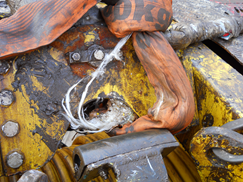Failure of lifting equipment: Dropped ROV
A member has reported an incident during offshore lifting operations in which a sling failed, causing an ROV and TMS to drop 30cm onto deck. The incident occurred during moving of the ROV and TMS. The whole assembly, weighing approximately 8 tonnes, was directly slung to the hook of the vessel’s crane using a 10 tonne round fibre sling choked around the main lifting eye. The failure of the sling happened when the load was swung towards its temporary landing spot, after it had been lifted from its initial position. The sling failed suddenly and completely, causing the ROV/TMS assembly to drop from 30 cm onto the deck. There were no injuries, but the frame of the ROV was noticeably damaged.




Our member’s investigation revealed the following:
- The company’s own safety management system was not followed by the involved personnel (watch-keeping officer, sub-contractor-s staff and crane operator);
- No lift plan was conducted before the start of the operations;
- The on-duty deck foreman was not present on deck to supervise the operations;
- The adequate rigging equipment and accessories (9.7 tonne four leg assembly and four 4.75 tonne bow shackles) required to lift this particular load was not used, and a 10 tonne round fibre sling was used instead;
- The fibre sling was choked around a sharp edge, and no protection or ‘packing’ was placed between the sling and the sharp edge.
Our member identified the following preventative actions:
- Remind all personnel onboard vessels, including sub-contractors and client personnel, to follow company safety management system, particularly with respect to lifting operations;
- Ensure lift plans are undertaken before every lifting operation, and ensure lift plan is strictly followed during lifting operations;
- Ensure the on-duty deck foreman is always present on deck to supervise any rigging and lifting operations;
- Ensure that only certified and adequate rigging and lifting equipment and accessories are used;
- Ensure that improvised solutions are never used for lifting operations;
- Ensure the rigging and lifting equipment and accessories cannot be damaged by sharp edges, chemicals, hot items etc.;
- Where appropriate, place protection or ‘packing’ between slings and any identified sharp edges;
- Remind personnel that sharp edges do not have to be ‘razor-sharp’ to cause failure of rigging equipment.
Members may wish to refer to the following IMCA documents, in particular the pocket safety cards which are intended for use by vessel crews:
- Guidelines for lifting operations
- Avoiding dropped objects (poster)
- Lifting equipment (pocket card)
- Avoiding dropped objects (pocket card)
Safety Event
Published: 18 June 2013
Download: IMCA SF 09/13
IMCA Safety Flashes
Submit a Report
IMCA Safety Flashes summarise key safety matters and incidents, allowing lessons to be more easily learnt for the benefit of all. The effectiveness of the IMCA Safety Flash system depends on Members sharing information and so avoiding repeat incidents. Please consider adding [email protected] to your internal distribution list for safety alerts or manually submitting information on incidents you consider may be relevant. All information is anonymised or sanitised, as appropriate.
IMCA’s store terms and conditions (https://www.imca-int.com/legal-notices/terms/) apply to all downloads from IMCA’s website, including this document.
IMCA makes every effort to ensure the accuracy and reliability of the data contained in the documents it publishes, but IMCA shall not be liable for any guidance and/or recommendation and/or statement herein contained. The information contained in this document does not fulfil or replace any individual’s or Member's legal, regulatory or other duties or obligations in respect of their operations. Individuals and Members remain solely responsible for the safe, lawful and proper conduct of their operations.
